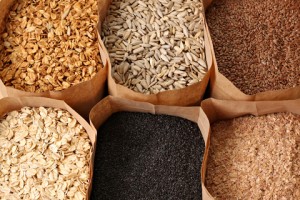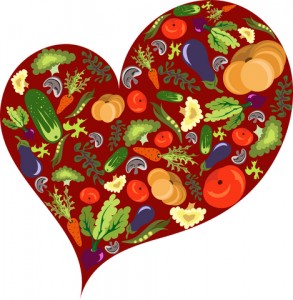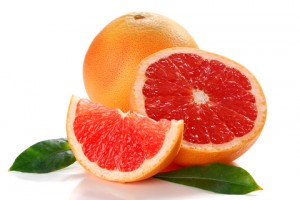Category — Healthy Living
Get Your Summer CSA On, Now!

Happy Thursday, folks! As most of you know, I bought into a great winter CSA this year – the Shared Harvest CSA. I’ve also already bought a share in the Picadilly Farm CSA for this summer. It’ll be my first year with them, but I’ve heard great things and the produce they contributed to the Shared Harvest haul was outstanding. If you’re interested in joining a CSA for the upcoming season, now’s the time to sign up. Shares are going fast.
But what’s that you say? You don’t know where to go? I have two resources for you. One’s for anyone, anywhere – LocalHarvestprovides a searchable database so you can locate a CSA that’s near you (most have weekly pickup, so location is essential . . . don’t wanna schlep too far for those veggies, do we?). The second is geared toward folks in the Arlington, Belmont, Cambridge and Lexington, MA zone - a CSA Share Fair that’s taking place next month in Arlington – organized by the intrepid Gretta Anderson, the brains and brawn behind the Shared Harvest CSA. See details below, and here’s to dreamin’ ‘bout all those “above-ground” veggies coming our way in just a few months!
What: A CSA Farm Share Fair in Arlington! CSA farmers will be on hand to tell you how their CSA works, what they are growing this year and how you can get a share of their harvest.
When: Thursday, February 25, 6:00 PM
Where: 50 Paul Revere Road, Arlington, MA at the Park Avenue Congregational Church in Arlington Heights, the Parish Hall.
Who: Farms that distribute CSA shares in Arlington, N. Cambridge, Lexington, Belmont, and nearby towns have been invited to participate, as have several local community farms.
Why: If you haven’t lined up your CSA share yet, the Farm Share Fair is a great place to learn about what’s available. You will be able to sign up for summer and winter CSA shares at the Fair. For those of you who have already purchased your 2010 CSA share, this is a great opportunity to say hello to your farmer. We are also inviting farmers to bring and sell their produce to the Fair, so you may want to bring your shopping bags!
Want to help? Gretta’s looking for volunteers who want to help make this Fair a success. Contact her directly if you’d like to help in any way: GrettaAnderson@earthlink.net, or 781.507.6602.
January 28, 2010 2 Comments
A Whole Grain Primer

You’ve heard that you’re supposed to eat more of them, but what the heck are whole grains, exactly?
Whole grains are grains that haven’t had their bran and germ removed by milling. They’re considered a better source of fiber, nutrients and antioxidants than their refined cousins. Whole grains can decrease cholesterol levels, blood pressure and risk of heart disease, and some studies have found that whole grains help reduce the risks of certain types of cancer.
The whole grain family includes brown rice, buckwheat, farro, millet, oatmeal, whole-wheat flour and whole cornmeal, among others. The FDA recommends eating at least three one-ounce equivalents of whole grains per day. Want to see if your packaged food product contains whole grain? It’s easy. Just look for the word “whole” in the ingredient list.
If you’re a refined-grain guru, incorporating whole grains into the diet might seem like a pain, but trust me, it’s pretty painless if you start small. For instance, substitute whole-wheat pasta or go for whole-grain bread products (think bagels, English muffins, tortillas, etc.) for white-flour options. Or if you’re baking, try using half whole-wheat pastry flour in cookie, cake or pie recipes. I’ve had particular luck with this in bar-cookie recipes, like these pumpkin chocolate chip squares (it’s also been virtually undetectable in 7-layer bars and other bar cookies). Whole wheat pastry flour is a much finer grind than regular whole-wheat flour, and while yes, the texture is a little teeny bit different, it’s not off-putting. In fact, once you get used to it, you might actually prefer the slightly nutty taste of the whole wheat pastry flour.
A dinner-time suggestion: Try brown rice instead of white. Use vegetable or chicken broth rather than water (same ratio as white rice – two cups broth to one cup of rice, and try adding a teaspoon of olive oil and a pinch of salt to boost the flavor). Or switch out rice altogether and give quinoa a whirl. If you’ve read this blog for a while, you know that I’m a huge fan of this high-protein seed. It acts like a grain, cooks quickly and has a light, nutty flavor. [Read more →]
January 27, 2010 1 Comment
Guest Post: Play More, Eat Less

In today’s guest post, Daniel Max reminds us that we can take the emphasis off food by finding something that really engages us . . . .
***************************************************************
Do you remember being a child and getting so wrapped up in creative play that you didn’t want to stop when it was time to eat or left your meal half-finished to get back to your game? Children innately understand that food is secondary to what is most nutritious and primary in life: fun and play.
As adults we seem to have lost our instinct to prioritize play. In our busy world, with its emphasis on work and responsibility, in order to be healthy and balanced we must work on more than just our bodies; we must feed our hearts, minds and spirits.
When our body, mind and spirit are engaged in a creative project or happy relationships, our reliance on food may appear to decrease. Likewise, when unsatisfied with relationships, job or other areas of our life, we often depend on food to cheer, soothe or numb us. When our life is out of balance, no amount of food can feed us where we truly need nourishment. The food that we eat is very important for health and balance, but what really feeds us-a full and fulfilling life-doesn’t come on a plate.
Putting things that excite us on hold for the sake of responsibilities may at times be good logic yet we often make these decisions from a place of fear rather than good sense. “If I’ll lose weight, then I’ll start swimming/ buy new clothes/ start yoga….” Let’s do the things we want to do NOW. Any statement containing “if I achieve__then I’d be happy” never holds truth and brings nothing but dissatisfaction. While our future goals are a motivation to better ourselves, they do not hold back our happiness. Finding a peaceful pleasure in our current state of being will motivate us to progress from a sense of ease. We stop working away from what we don’t want and work towards moving towards what we do want.
Create a positive attitude and wonderful environment around you and enjoy the process of becoming healthier and happier every step of the way!
Have fun. If going to the gym is a “chore” then try a yoga or dance class instead. Find a way to play while moving your body. If by deciding to eat healthy you are mostly focused on what to restrict, shift your focus to all the new foods and flavors you get to incorporate and explore.
What is fun for you? What makes you light up and excites you? Make time for it this week. Even if you don’t have much time for fun, try approaching a “serious” activity with an attitude of play. This can greatly reduce stress and anxiety and bring more pleasure to your day. Take your focus off food, try adding more fun into your life and watch the magic unfold.
 Daniel Max is a Nutrition and Health Counselor, Life & Wellness Coach, Massage Therapist specializing in Shiatsu, and a Yoga Instructor. Providing an integrative approach to naturally reclaim control of your health, Daniel offers an initial hour-long consultation. Gaining a greater perspective on your health, this session includes a full discussion of your health history and health goals, a chance to get your questions answered and establish your first steps in creating a personalized health program, completely catered toward your lifestyle and needs. Consultations are available either by phone or in person. To Learn more about Daniel and his services, visit www.MaxSenseOfSelf.com.
Daniel Max is a Nutrition and Health Counselor, Life & Wellness Coach, Massage Therapist specializing in Shiatsu, and a Yoga Instructor. Providing an integrative approach to naturally reclaim control of your health, Daniel offers an initial hour-long consultation. Gaining a greater perspective on your health, this session includes a full discussion of your health history and health goals, a chance to get your questions answered and establish your first steps in creating a personalized health program, completely catered toward your lifestyle and needs. Consultations are available either by phone or in person. To Learn more about Daniel and his services, visit www.MaxSenseOfSelf.com.
January 26, 2010 No Comments
10 for ’10

January’s not over yet, how are your goals and resolutions coming along? Are you making progress? As my trainer likes to say “progress, not perfection!” She’s on to something . . . if we strive for perfection, we set ourselves up for disappointment. If we seek to progress, then we allow ourselves to celebrate each small step on the way to our ultimate goal.
On this theme, here’s a list of 10 ways you can healthy-up your life in 2010 - some small changes to set you on a path to better living in the new year.
1. Ease up on animal fats. Animal products can contain synthetic hormones, antibiotics and chemicals such as dioxin, DDT and other pesticides, which concentrate in animal fat. The chemicals that accumulate in animal fats are transferred to our bodies when we eat them. When buying meat, poultry or dairy, look for low fat options. You can also do your body a favor by reducing how much meat you eat. Making even one vegetarian meal a week can make a big difference.
2. Go organic where you can. According to the Environmental Working Group, you can lower your pesticide exposure by 90% by avoiding the most contaminated conventionally grown produce: peaches, apples, sweet bell peppers, celery, nectarines, strawberries, cherries, lettuce, imported grapes, carrots, and pears. You can download the EWG pocket guide to fruits and veggies here.
3. Ban the can. Canned foods and beverages are lined with a resin that contains bisphenol-A (BPA), a hormone-disrupting chemical that’s building up in our environment and our bodies. The FDA is investigating as we speak, and most manufacturers are beginning to explore safer alternatives, but in the meantime you should choose foods that are fresh, dried, frozen or packaged in glass jars or tetra packs.
4. Read food labels – for real. Ever stop to read the ingredients label on packaged, processed foods? Learn which food additives are safer by visiting The Center for Science in the Public Interest’s food safety guide. Remember this: The shorter the list of ingredients, the less processed the food, and the less processed the food, the better it is for your body.
5. Wet your whistle with water. Americans drink an overwhelming amount of soda, sports drinks, energy boosters, juices and other bottled beverages. Many of these drinks are loaded with sweeteners and artificial flavors and colors. They’re also often bottled in plastic, which can leach additional chemicals into your drink. Make an investment in a reusable stainless steel bottle, and get in the habit of filling it with water before you leave the house.
6. Eat-in more often. When you eat at a restaurant or stop for take-out, you have very little control over what you’re eating. Save money, protect your health, and trim your waistline by cooking at home. Look for inspiration here at Semi-Sweet, and also check out my links for fast and flavorful recipes that’ll ease your dependence on take-out and increase your intake of whole foods, fruits and veggies.
7. Use fewer personal care products and use them less often. Our government doesn’t currently require health studies or pre-market testing for personal-care products before they’re sold. Nearly 90% of ingredients used in personal care products haven’t been evaluated for safety by any publicly accountable institution. Nearly all these chemicals can penetrate the skin, and some we ingest directly from our lips or hands. Visit the Campaign For Safe Cosmetics to learn more and to see what’s really in those products you use every day.
8. Kick the non-stick. Non-stick pans are coated with synthetic chemicals, and when the cook-surface gets scratched, tiny, yet toxic bits of inert plastic and leached aluminum cling to your food. What’s more, these pans emit toxic fumes when overheated. The safest alternatives are cast iron, stainless steel and oven-safe glass. If you have unscratched non-stick cookware and can’t afford to replace it right now, you can reduce the possibility of toxic fumes by cooking smart: never preheat nonstick cookware at high heat, don’t put it in an oven hotter than 500 degrees and use an exhaust fan over the stove.
9. Store & reheat leftovers safely. Avoid plastic when storing and re-heating leftovers. We know that chemicals routinely migrate into food and liquid placed in plastic containers and that heat accelerates the process. Use a paper towel instead of plastic wrap to cover food in the microwave, and use glass or ceramic food storage containers.
10. Clean greener. Our homes aren’t safe and clean if the air inside is polluted with chemicals from household cleaners. It’s pretty easy: Try natural alternatives (vinegar, baking soda and water); avoid anti-bacterials; and avoid the biggest hazards (acidic toilet bowl cleaners, air fresheners, oven cleaners, and corrosive drain openers).
January 25, 2010 4 Comments
Thursday Night Recap

Happy Friday morning, all! We had a great time at Healthy Habits Kitchen last night – thanks to Sue for hosting us (and for providing tasty treats!) and to Liz Ward for giving us all great advice on how to make nutrition a family affair. I think we all came away with some great ideas for how to feed our families (and ourselves) a little bit better.
Liz’s advice was balanced and practical – and comes from a place of inclusion rather than exclusion of specific foods. This anti-deprivation message works well for us and for our kids: Instead of thinking of all the foods you “can’t” have (i.e., chips, cookies, Goldfish, Cheetos, etc.), think of all the nutrient rich-foods you can have (whole fruits, vegetables, whole-grain breads, low-fat milk, lean sources of beef, fish, chicken, nuts, etc. etc.). These whole foods add value to your diet. At our house, we call them “grow foods,” as distinguished from “treats,” which taste great and are fun to eat, but which we eat occasionally, not regularly. We let L. pick, choose, and eat as many “grow foods” as she likes, while we seek to limit (and have her self-limit) her intake of treats.
My #1 revelatory idea from the night was that it’s not a great idea to try to introduce new foods to your child when s/he is tired, overstimulated, etc. This was a lightbulb moment for me because I realized that we most often try to get L. to try new things at dinnertime – a time of, well, bonkers behavior most nights. So I’m going to try more during a weekend lunch, the afternoons or mornings on weekends, etc.
Another important take-away for parents is to try to manage your own anxiety about your child’s eating habits . . . let your desire for them to eat a balanced diet come from a place of love and interest, rather than a place of fear . . . because as Liz said, when fear takes over, all you-know-what can break loose. Or, as I say, kids can smell fear – and boy, do they capitalize on it!
I hope you all have a great, healthy weekend, and I’ll see you back here on Monday!
January 22, 2010 2 Comments
Distinguishing Appetite From Hunger

‘Tis the season for re-evaluating our weight and nutrition goals, no? The gyms are packed, the diet center ads are running constantly, and around this time, people generally resolve to “lose weight” and/or “get healthy,” once and for all . . . .
There are lots of obstacles to losing weight and eating healthily – you probably know what they are for you. But have you thought about why you eat in the first place? We generally have two reasons for eating: hunger and appetite. The two are completely different, and keying into which is motivating you at any given moment may help you push away from the table or avoid foods that might sabotage your healthful eating efforts.
What is Hunger?
Hunger is the ‘need for food’. Your body lets you know you’re running low on fuel and that food’s needed to give your body the energy it needs to perform an activity. Hunger instinctively protects the body from depleting energy reserves.
What is Appetite?
Appetite, on the other hand, is described as the desire, or craving for food. It might be prompted by the sight or smell of food. Passing a bakery and smelling fresh baked goods is an example. Your stomach may be full because you’ve just eaten, but the smell and sight of the bread and desserts stimulates your appetite.
Habits and moods affect our appetite, too. Many of us eat out of habit (i.e. noon=lunchtime regardless of whether you’re actually hungry), or in response to various moods like sadness, anger, anxiety or boredom. Habits and emotional stimuli can be very powerful cues to eat, and very often, to overeat.
How to Tell Them Apart?
Knowing the difference between hunger and appetite is half the battle when it comes to weight loss. Tune in to your body before you start eating and ask yourself whether you’re truly hungry, or whether there’s something else going on.
For some people, an effective way to get at this is to keep a journal for a week or two. For every time you eat, write down (1) what you ate, and (2) the circumstances of your eating – meaning, what caused you to eat, how you felt when you ate. I’ve never incorporated emotions/circumstances into my food diary, but I know that it can be enormously powerful for some people – if you have any interest in doing this, I’d go for it. It can’t hurt and it could provide some valuable insight.
I have to confess, I only started thinking of the distinction between my hunger and my appetite recently. I know that in the past I ate when I was sad or depressed, and now I know that boredom is a trigger for me to munch, but I had never really thought about the technical definitions of hunger and appetite. Since I have been, I realize that my appetite is also stimulated by reading and writing about food – which I of course do for a few hours every day. I now realize that I have a huge appetite, but my actual hunger level is often fairly low. If I take a minute and wait before heading to the fridge or cabinet, I can often derail eating based on merely appetite, and not hunger.
This is all best boiled down to Emma Fogt’s “food rule,” submitted to Michael Pollan when he solicited readers’ tips for eating healthfully. It bears repeating to yourself when you’re going for that handful of Cheez-its: “If you’re not hungry enough to eat an apple, then you are not hungry.”
January 13, 2010 4 Comments
Special Saturday Reminder . . . .

Folks, it’s nuts out there. I’ve been out and about all a.m. and it’s not pretty. Big snow predicted for the Boston area, plus Christmas around the corner = madness on the roads, in the stores, etc. As I headed out to the supermarket at 8:30 this morning, I said to myself “it might be bonkers out there, but today you’re going to remember all the joy in your life, and you’re going to be nice and friendly.” Sound crazy? Many of you haven’t driven with me before, but let me assure you, I’m Boston-born and bred, and I drive like hellfire and I swear like a sailor (if my youngest Midwestern cousin is reading this, he will remember a little incident many years ago that involved, I think, a rotary, a stick-shift, some yelling and some graphic hand gesturing). So this little pep-talk was necessary.
And it worked out OK, but I was, shall I say, tested. I’m home now, fed and ready to start prepping food for a very fun annual Festivus gathering tonight, and checking Google Reader – I came across this post from the Crazy Sexy Life Blog. Not sure how much you can use suggestion #1 at this late date, but the rest is so good and such a good reminder that I’m breaking tradition and blogging on the weekend.
My favorite quotation is: ”you are the architect of all of your life experiences.” Take that one along in your back pocket for the next week or so. And further indulge me as I plug in another great reminder about being in the moment, from Pema Chodron:
“There is a story of a woman running away from tigers. She runs and runs and the tigers are getting closer and closer. When she comes to the edge of a cliff, she sees some vines there, so she climbs down and holds on to the vines. Looking down, she sees that there are tigers below her as well. She then notices that a mouse is gnawing away at the vine to which she is clinging. She also sees a beautiful little bunch of strawberries close to her, growing out of a clump of grass. She looks up and she looks down. She looks at the mouse. Then she just takes a strawberry, puts it in her mouth, and enjoys it thoroughly. Tigers above, tigers below. This is actually the predicament that we are always in, in terms of our birth and death. Each moment is just what it is. It might be the only moment of our life; it might be the only strawberry we’ll ever eat. We could get depressed about it, or we could finally appreciate it and delight in the preciousness of every single moment of our life.”
Good luck this weekend, everyone, snow or no snow, Christmas prepping or not. Breathe deep, be present, eat well, and I’ll see you back here on Monday morning.
December 19, 2009 1 Comment
Gaga for Grapefruit

I know it’s not local, but of all the citrus fruits, my favorite is grapefruit. Every winter, I look forward to seeing the first grapefruit at the market, and I eat a grapefruit every day. I love it at breakfast time, for an afternoon snack or as dessert after dinner. This girl cannot live by root vegetables alone. Especially since I’m still makin’ my way through my all-local Moroccan Veggie Stew . . . .
Grapefruit has a lot of vitamins C and A. The pink and red kinds have more phytonutrients than the white – they’ve got lycopene, which may help to protect against certain forms of cancer (see also, tomatoes and watermelon). Both blond and red grapefruit can reduce blood levels of LDL (“bad”) cholesterol, and a recent study showed that red grapefruit can lower triglycerides too. And at about 50 calories per half grapefruit, it’s a great way to eat for your health.
Is there a downside to grapefruit? Yes, grapefruit and/or its juice may interact with certain medications (statins among them), so if you eat the fruit or drink the juice regularly be sure to ask your doc if it could affect any medications you are taking. And also concerning: A 2007 study suggested a link between grapefruit consumption and breast cancer in post-menopausal women. There’s conflicting evidence on this, though – in ’08, the Nurses’ Health Study found the opposite.
Ways to eat your grapefruit:
- Plain
- With a sprinkle of granulated sugar or a drizzle of honey on top
- On a green or spinach salad
- Juice in a juicer
- Add a little to perk up your green monster smoothie – a green apple, a few handfuls of spinach, and some grapefruit is really refreshing
- Dip it in melted dark chocolate
- Add it to fruit salads
- Squeeze a wedge into a glass of water for a refreshing hydrator
- Blend with olive oil, herbs and spices for a delicious salad dressing
- Combine with olive oil, garlic, salt and pepper as a marinade for chicken
- Top grapefruit halves with a little cinnamon and honey and broil for a couple of minutes
For a regional citrus resource – check out this post from Eat Local, Boston about a winter citrus CSA share comin’ up the East Coast versus from overseas or the West Coast . . . . orders have to be in by the 14th of this month – and if you choose to partake, let me know what you think, will you?
I leave you with grapefruit trivia: Do you why a grapefruit is called grapefruit? I just learned this – maybe I’m the last to know!?
December 9, 2009 3 Comments









